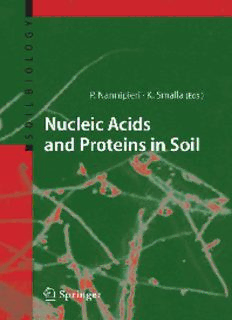
Nucleic Acids and Proteins in Soil PDF
Preview Nucleic Acids and Proteins in Soil
Soil Biology 8 Series Editor: Ajit Varma Volumespublishedintheseries Volume1 A.Singh,O.P.Ward(Eds.) AppliedBioremediationandPhytoremediation 2004 Volume2 A.Singh,O.P.Ward(Eds.) BiodegradationandBioremediation 2004 Volume3 F.Buscot,A.Varma(Eds.) MicroorganismsinSoils:RolesinGenesisandFunctions 2005 Volume4 S.Declerck,D.-G.Strullu,J.A.Fortin(Eds.) InVitroCultureofMycorrhizas 2005 Volume5 R.Margesin,F.Schinner(Eds.) ManualforSoilAnalysis– MonitoringandAssessingSoilBioremediation 2005 Volume6 H.König,A.Varma(Eds.) IntestinalMicroorganismsofTermites andOtherInvertebrates 2006 Volume7 K.G.Mukerji,C.Manoharachary,J.Singh(Eds.) MicrobialActivityintheRhizosphere 2006 P. Nannipieri K. Smalla (Eds.) Nucleic Acids and Proteins in Soil With42Figures,2inColor 123 ProfessorPaoloNannipieri DipartimentodellaScienza delSuoloeNutrizionedellaPianta P.ledelleCascine28 50144Firenze Italy e-mail:paolo.nannipieri@unifi.it Dr.KorneliaSmalla BiologischeBundesanstalt fürLand-undForstwirtschaft(BBA) InstitutfürPflanzenvirologie, MikrobiologieundbiologischeSicherheit Messeweg11/12 38104Braunschweig Germany e-mail:[email protected] LibraryofCongressControlNumber:2005938057 ISSN1613-3382 ISBN-103-540-29448-1SpringerBerlinHeidelbergNewYork ISBN-13978-3-540-29448-1SpringerBerlinHeidelbergNewYork This work is subject to copyright. All rights reserved, whether the whole or part of the materialisconcerned,specificallytherightsoftranslation,reprinting,reuseofillustrations, recitation,broadcasting,reproductiononmicrofilmorinanyotherway,andstorageindata banks.Duplicationofthispublicationorpartsthereofispermittedonlyundertheprovisions oftheGermanCopyrightLawofSeptember9,1965,initscurrentversion,andpermission forusemustalwaysbeobtainedfromSpringer.Violationsareliableforprosecutionunder theGermanCopyrightLaw. SpringerisapartofSpringerScience+BusinessMedia springer.com ©Springer-VerlagBerlinHeidelberg2006 PrintedinGermany Theuseofgeneraldescriptivenames,registerednames,trademarks,etc.inthispublication doesnotimply,evenintheabsenceofaspecificstatement,thatsuchnamesareexempt fromtherelevantprotectivelawsandregulationsandthereforefreeforgeneraluse. Coverdesign:design&production,Heidelberg,Germany Typesettingandproduction:LE-TEXJelonek,Schmidt&VöcklerGbR,Leipzig,Germany 31/3150-YL-543210-Printedonacid-freepaper Preface Thisbookisdevotedtonucleicacidsandproteinsinsoil.Theintentionis tocompileourpresentknowledgeandunderstandingoftheimportanceof nucleicacidsandproteinspresentinsoileitherinsideoroutsideofmicro- bialcells.Sincemicrobe-drivenfunctionsarekeyforanenormousrangeof nutrientcyclingandgeochemicalprocessesinsoilitisexpectedthatabet- terunderstandingofthestructuralandfunctionaldiversityanddynamics of the microbial community will enable us to understand and eventually predict or manage soil functions of importance. This is the reason why therearesomanychaptersonsoilmicrobialcommunityanalysisinabook entitled “Nucleic acids and proteins in soil”. The rather ambitious idea behind the book was to link traditional soil microbiology, biochemistry and chemistry approaches with the more recently developed ones in the fieldofmolecularmicrobialecology,allaimingatabetterunderstanding of soil functioning. Whereas only a few studies on the analysis of nucleic acidsinsoilhadbeencarriedoutbeforethe1990s,thebibliographyonthe extractionofenzymes,interactionsbetweenproteinsandsoilcolloidsand quantificationofproteinNinsoilwasatthattimealreadyratherextensive. The first chapter by Stres and Tiedje is entitled “The new frontiers in soil microbiology: how to link structure and function of microbial com- munities?”. Stres and Tiedje consider the attempt to link microbial com- munity structure and function in a predictive way as a “Decadal Grand Challenge” in particularbecause microbial communities in soils are very diverseandcomplex,andvaryatverysmallscales.Severalchaptersofthe bookdealwithrecentmethodologicaladvancesmadetouncoverthelinks between structure and functions of soil microbial diversity. The basis of most cultivation-independent approaches is the extraction of either nu- cleic acids or proteins directly from soil. In Chaps. 3 and 11, written by BakkenandFrostegårdandbyWellingtonetal.,thereaderwilllearnmore abouttheongoingchallengetoobtainnucleicacidsfromthe“dirt”which aresuitableformolecularanalysis.Thedifferentstepsrequiredfornucleic acid extraction are shown, secrets and useful tricks are mentioned, and thevariouspotentialbiasesarecriticallydiscussed.InChap.3,Bakkenand FrostegårdcitealinefromoneofLeonardCohen’ssongs,“...thereisacrack ineverything,that’showthelightcomesin”;abiasedmethodisproblem- VI Preface atic(cracks)untilweknowtheextentandthereasonsforthebias.Withthat knowledge,experimentscanbedesignedtoexploitthebiastounravelnew phenomena (“... how the light comes in”), and this rather philosophical considerationseemsanappropriateapproachformanymethodsdiscussed inthisbook.Themolecularanalysisofnucleicacidsextractedfromsoils allowsusconversationwiththesilentmajorityofsoilmicrobes.Whilethe analysis of polymerase chain reaction (PCR)-amplified rRNA genes from TC-NAbycommunityfingerprintingtechniquesorcloningandsequencing (Chaps.8and11)isnowadaysastandardtechnique,theuseofgenearrays for structural and functional analysis of soil microbial communities still remainsahugemethodologicalchallenge(seeChap.9).Whenthesetech- niquesareappliedforTC-NAanalysisanideaofthekindsofnumerically dominantmicrobialpopulationsandgenes presentisobtained.However, in general, these approaches give us relatively little idea about the in situ metabolicfunctions.Onepowerfultoolformicrobialecologistsproviding a culture-independent means of identifying microbial populations con- ducting certain microbial processes is stable isotope probing (SIP). The potentialsandlimitationsofSIPareaddressedinChap.10byManefieldet al. In recent years, the detectionand quantificationof gene expressionin soilhasbecomefeasible,asillustratedinChap.11byWellingtonetal.The obviousnextstepistheanalysisofthesoilproteome,asubjectdiscussed inthechaptersbyOgunseitanandNannipieri(Chaps.5and4).Although this methodological approach is still in its infancy it can certainly make useofthelong-termexperienceinanalysingproteinsinsoil. Onlyrecentlyhasthefullextenttowhichhorizontalgenetransferpro- cesses drive bacterial diversity and adaptability become evident. Three chapters of this book are devoted to this issue. How to assess the abun- dance and diversity of mobile genetic elements (MGE) in soil bacterial communities?Methodspresentlyused,theirpotentialsandlimitationsare summarisedinthechapterbySmallaandHeuer(Chap.13).Acomprehen- sive overview of our present knowledge on gene transfer by conjugation in soil and the various biotic and abiotic factors influencing frequencies and establishment is given in Chap. 14 by Van Elsas et al. Chap. 15 on transformationbyMercieretal.makesthelinkbetweenfreeDNAinsoil and bacteria with a particular emphasis on the transformation of bacte- ria by transgenic or transplastomic DNA. As discussed by Nielsen et al. inChap.7,theinteractionsofnucleicacidsandproteinswithsoilcolloids protectthesemoleculesagainstenzymaticdegradation.Indeed,anintrigu- ing aspect of soil as a biological system is the capacity of soil colloids to adsorborentrapimportantmoleculessuchasnucleicacidsandproteins. The origin of DNA in soil and the factors influencing the persistence are addressedbyWackernagelinChap.6.Nucleicacidsadsorbedorboundby clays are protected against degradation by nucleases. However, they can Preface VII be taken up by competent bacterial cells and can be integrated into the recipients’genomebyhomologousrecombinationorhomology-facilitated illegitimate recombination. A less microbe-focused and a broad view on state, location and function of enzymes in soil is given by Gianfreda and Ruggiero(Chap.12). Itisamazingthatonaverageonly4%ofthetotalNinsoilispresentin microbialbiomassNwhereasahighproportion(from30–50%)ispresent as amino acids after acid hydrolysis. Thus it is reasonable to hypothesise thattheamountofextracellularproteinNisalsoconsiderableanditismuch higherthantheamountofintracellularproteinNinsoil(seeChaps.2and4, respectively).Indeed,asdiscussedbyKögel-KnabnerinChap.2,theuseof NMRhasconfirmedthatextracellularproteinNispresentinsoil. The final three chapters of this book (Chaps. 16–18) concentrate on marker and reporter genes and their use in soil microbial ecology. Al- though these techniques rely on introduced microbes equipped with re- spective marker and reporter genes, they allow researchers not only to follow the fate and activity of introduced microbes, but also to discover how they respond to environmental triggers. Thus these techniques con- siderably contribute to a better understanding of the microenvironment surrounding microorganisms inhabiting soil and to locally quantify the activityofstimulators,inhibitorsandpollutantswithabetterlinkbetween soilmicrobiologyandsoilchemistryandbiochemistry. Generally,theinformationobtainedbyusingmoleculartechniquesare consideredaspartof‘modern’soilmicrobiologyandbiochemistry,whereas theinformationretrievedbyclassicaltechniques,suchassoilrespiration, microbialbiomass,enzymeactivities,etc., areconsideredasblackboxes, sumparametersandroughestimates.Perhapsforthisreasonthereisaten- dencytoseparatethetwoapproacheswhichisconceptuallywrong.Inthis book we have tried to overcome this separation because, in our opinion, both approaches should be more often combined to gain better insight into the microbial processes occurring in soil. The use of stable isotope probing(seeChap.10)isoneofthemostfruitfulcombinationsofthetwo approaches. Firenze, PaoloNannipieri Braunschweig, KorneliaSmalla December2005 Contents 1 NewFrontiersinSoilMicrobiology: HowToLinkStructureandFunctionofMicrobialCommunities? 1 BlažStres,JamesM.Tiedje 1.1 Introduction: AFrameworkfortheStructure–FunctionGrandChallenge... 1 1.2 MicrobialCommunityStructure: One-HalfoftheStructure–FunctionParadigm.................... 3 1.3 TheOtherOne-Half: FunctionalTraitsofMicrobialCommunities....................... 6 1.4 NewerApproachesforLinkingFunction withPhylogenyandStructure........................................... 9 1.5 FutureChallenges........................................................... 12 References............................................................................. 17 2 ChemicalStructureofOrganicNandOrganicPinSoil 23 IngridKögel-Knabner 2.1 Introduction.................................................................. 23 2.2 BiologicalFormsofOrganicNandPThatEnterSoils.......... 24 2.2.1 ProteinsandPolypeptides..................................... 25 2.2.2 AminoSugarPolymers ......................................... 27 2.2.3 DNAandRNA..................................................... 28 2.2.4 MinorN-ContainingMolecules.............................. 29 2.2.5 TeichoicAcids...................................................... 29 2.2.6 InositolPhosphates.............................................. 31 2.2.7 Phospholipids...................................................... 31 2.3 TechniquesToAnalyseSoilOrganicNitrogen..................... 32 2.3.1 Hydrolysis........................................................... 33 2.3.2 AnalyticalPyrolysisandThermochemolysis............ 34 2.3.3 Solid-State15NNMRSpectroscopy.......................... 35 2.3.4 X-rayAbsorptionNear-Edge StructureSpectroscopy......................................... 36 2.4 FormsofOrganicNinSoilOrganicMatter......................... 37 X Contents 2.5 TechniquesToAnalyseOrganicPinSoils........................... 39 2.5.1 SequentialExtractionandSeparation...................... 40 2.5.2 31PNMRSpectroscopy.......................................... 40 2.6 FormsofOrganicPinSoils.............................................. 42 2.7 Summary....................................................................... 43 References............................................................................. 43 3 NucleicAcidExtractionfromSoil 49 LarsR.Bakken,ÅsaFrostegård 3.1 Introduction.................................................................. 49 3.2 LysisandExtraction........................................................ 51 3.2.1 CellRuptureDependsonCellTypeandGrowth........ 51 3.2.2 BeadBeating,EfficiencyandBias ........................... 52 3.2.3 Grinding............................................................. 56 3.2.4 Freeze/Thaw........................................................ 57 3.2.5 EnzymaticLysis................................................... 57 3.2.6 ChemicalAgents.................................................. 59 3.2.7 ExtractionforMetagenomeLibraries...................... 59 3.3 Purification.................................................................... 60 3.4 RNAExtraction.............................................................. 62 3.5 CellExtraction............................................................... 63 3.5.1 Dispersion .......................................................... 64 3.5.2 Separation........................................................... 65 References............................................................................. 67 4 RoleofStabilisedEnzymesinMicrobialEcology andEnzymeExtractionfromSoilwithPotentialApplications inSoilProteomics 75 PaoloNannipieri 4.1 Introduction.................................................................. 75 4.2 EvidenceforthePresenceofStabilisedEnzymesinSoil........ 77 4.3 ExtractionofEnzymesfromSoil....................................... 79 4.4 TheRoleofStabilisedEnzymesinSoilMicrobialEcology..... 82 4.5 Proteomics .................................................................... 83 4.6 SoilProteomics .............................................................. 85 4.7 Conclusions................................................................... 89 References............................................................................. 90 5 SoilProteomics:ExtractionandAnalysisofProteinsfromSoils 95 OladeleA.Ogunseitan 5.1 Introduction.................................................................. 95 5.2 RationaleandContextofSoilProteomics........................... 96
Description: